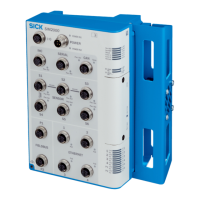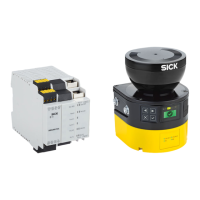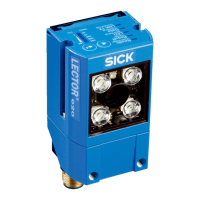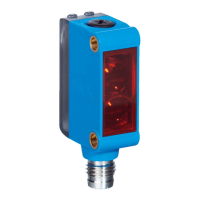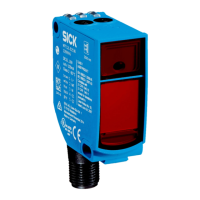Table 17: State of the channels of the control inputs for a parity check using 3channels
P3.1 P3.2 P3.P Result (e.g., monitoring case no.)
0 0 1 0
0 1 0 1
1 0 0 2
1 1 1 3
Other input conditions Error
Table 18: State of the channels of the control inputs for a parity check using 4channels
P4.1 P4.2 P4.3 P4.P Result (e.g., monitoring case no.)
0 0 0 1 0
0 0 1 0 1
0 1 0 0 2
0 1 1 1 3
1 0 0 0 4
1 0 1 1 5
1 1 0 1 6
1 1 1 0 7
Other input conditions Error
Complementary information
•
W
hen the input signal is changed, the previous monitoring case remains active for
the duration of the set switch-on delay. If no valid input signal is present after the
switch-on delay has elapsed, the behavior depends on the sequence monitoring:
°
If monitoring of the switching sequence (sequence monitoring) is not acti‐
vated, the OSSDs switch to the OFF state after the switch-on delay has
elapsed. If a valid input signal is present within another second, the device
activates the new monitoring case. If no valid input signal is present within
this time, the OSSDs remain in the OFF state and the device displays an error
and must be restarted.
°
If monitoring of the switching sequence (sequence monitoring) is activated,
the OSSDs switch to the OFF state after the switch-on delay has elapsed and
the device displays an error and must be restarted.
•
A short-circuit or cross-circuit on one or more channels of the static control inputs
can cause the wrong monitoring case to be activated.
°
Some safety controllers detect the short-circuit or cross-circuit and switch off
their outputs or some of their outputs.
°
Due to the short-circuit or cross-circuit, one or more input channels of the
device can nevertheless deliver the HIGH signal level. This may result in a
valid input signal so that a monitoring case is activated.
°
For this reason, laying the cables for the input signals in a protected manner
is recommended. Otherwise, setting the switch-on delay to 0s and activating
sequence monitoring is recommended. Carrying out regular thorough checks
at short intervals is also recommended.
Further topics
•
"Se
ttings for monitoring case tables", page 73
•
"System connection", page 53
PROJECT PLANNING 4
8025919/1I9E/2023-01-09 | SICK O P E R A T I N G I N S T R U C T I O N S | safeVisionary2
43
Subject to change without notice
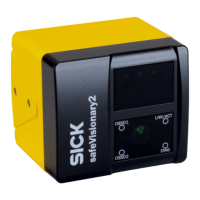
